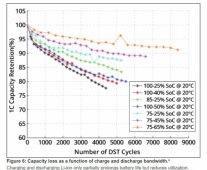Matty-Lee
New Member
- Joined
- Jan 21, 2021
- Messages
- 49
Q. Should I change some of the solar charger settings to get a longer life from my battery and what would your suggestions be?
Details below...
I've watched this video which explains how you can get more life out of your battery if you don't allow it to run down or charge up fully.
I think I'd quite like to do this as I have 12v 200ah battery that is pretty much feeding some LED lights and USB sockets so there should be lots of capacity but I'm a newbie so would like some advice to get it right.
The batteries are from https://www.aliexpress.com/item/1005001270537853.html and the spec says:
Nominal capacity: 200Ah
Minimum capacity: 200Ah
Internal impedance: 0.1 ~ 0.3mΩ
Nominal voltage: 3.2v size (length * width * height): 173 * 55 * 210mm
Weight: 3.9 ± 0.2kg
Recommended constant current: 200a (1c)
Discharge termination voltage: 2.5v
Recommended constant current: 200a (1c)
Charging voltage: 3.65v
Maximum continuous discharge current: 200a (1c)
Life cycle (80% dod): 4000 times
Cycle loading temperature: -5 60 60 ° c
Discharge temperature: -30 60 60 ° c
Production date: February 2020
Battery lithium iron lithium phosphate
The solar charger is EPEVER and I have it set up for LiFePO4 with these settings as recommended by the manufacturer:

Thanks,
Matt
Details below...
I've watched this video which explains how you can get more life out of your battery if you don't allow it to run down or charge up fully.
I think I'd quite like to do this as I have 12v 200ah battery that is pretty much feeding some LED lights and USB sockets so there should be lots of capacity but I'm a newbie so would like some advice to get it right.
The batteries are from https://www.aliexpress.com/item/1005001270537853.html and the spec says:
Nominal capacity: 200Ah
Minimum capacity: 200Ah
Internal impedance: 0.1 ~ 0.3mΩ
Nominal voltage: 3.2v size (length * width * height): 173 * 55 * 210mm
Weight: 3.9 ± 0.2kg
Recommended constant current: 200a (1c)
Discharge termination voltage: 2.5v
Recommended constant current: 200a (1c)
Charging voltage: 3.65v
Maximum continuous discharge current: 200a (1c)
Life cycle (80% dod): 4000 times
Cycle loading temperature: -5 60 60 ° c
Discharge temperature: -30 60 60 ° c
Production date: February 2020
Battery lithium iron lithium phosphate
The solar charger is EPEVER and I have it set up for LiFePO4 with these settings as recommended by the manufacturer:

Thanks,
Matt



